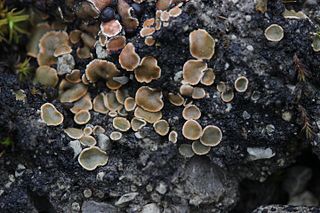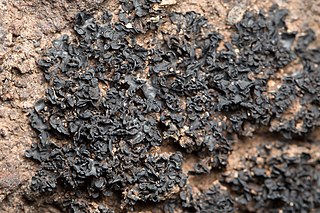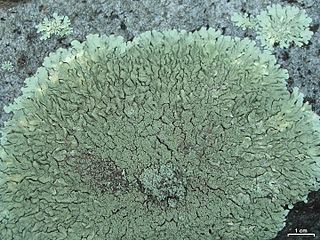
Psora is a genus of lichen-forming fungi in the family Psoraceae. Members of the genus are commonly called fishscale lichens. Lichens in the genus Psora generally have a squamulose thallus and anthraquinones in the hymenium. Photobiont partners of Psora lichens include members of the green algal genera Asterochloris, Chloroidium, Myrmecia, and Trebouxia.

Gloeoheppiaceae is a family of ascomycete fungi in the order Lichinales. The family contains ten species distributed amongst three genera. Most species are lichenised with cyanobacteria. Species in this family are mostly found in desert areas. Modern molecular phylogenetics analysis casts doubt on the phylogenetic validity of the family, suggesting a more appropriate placement of its species in the family Lichinaceae.

The Lichinaceae are a family of ascomycete fungi. Most species are lichenized with cyanobacteria, and have a distribution largely in temperate regions.

Diploschistes is a genus of lichen-forming fungi in the family Graphidaceae. Commonly known as crater lichens, members of the genus are crustose lichens with a thick, cracked (areolate) body (thallus) with worldwide distribution. The fruiting part (apothecia) are immersed in the thick thallus so as to have the appearance of being small "craters". The widespread genus contains about 43 species.

Xanthoparmelia is a genus of foliose lichens in the family Parmeliaceae. This genus of lichen is commonly found in the United States, as well as Australia, New Zealand and Ecuador.
Lichinodium is a genus of filamentous lichens. It is the only genus in the family Lichinodiaceae, itself the only member of the order Lichinodiales. Lichinodium has four species. Previously considered part of the class Lichinomycetes, molecular phylogenetic analysis revealed that Lichinodium represents a unique lineage in the Leotiomycetes—the first known group of lichen-forming fungi in this class.
Stromatella bermudana is a saxicolous (rock-dwelling) crustose lichen. It is the only species in Stromatella, a monotypic fungal genus in the family Lichinaceae. The genus was circumscribed in 1989 by German lichenologist Aino Henssen. This species was originally described as Psorotichia bermudana by US botanist Lincoln Ware Riddle in 1916, from specimens collected in Bermuda.
Zahlbrucknerella is a genus of filamentous, rock-dwelling lichens in the family Lichinaceae.

Thyrea is a genus of lichen-forming fungi in the family Lichinaceae. It contains four species that have been accepted by Species Fungorum. The genus was circumscribed by Italian lichenologist Abramo Bartolommeo Massalongo in 1856, with Thyrea plectospora assigned as the type species.

Megaspora is a genus of lichen-forming fungi in the family Megasporaceae. It contains four species of crustose lichens that typically grow on soil, bryophytes, or plant litter on chalky substrates.

Roccellinastrum is a genus of lichen-forming fungi in the family Pilocarpaceae. It has seven species.
Harpidiaceae is a small family of lichen-forming fungi, containing two genera and five species. It is of uncertain classification in the Pezizomycotina.
Aspiciliopsis is a genus of lichen-forming fungi in the family Trapeliaceae. It has two species, both of which occur in the Southern Hemisphere.
Upretia is a genus of lichen-forming fungi in the family Teloschistaceae. It has three species of saxicolous (rock-dwelling), crustose lichens. Upretia is characterised by its small ascospores and narrow, rod-shaped conidia. The distribution of the genus ranges from mid-altitude rocky terrains in India to both arid and higher altitudinal environments in China.
Lempholemma polycarpum is a little-known species of saxicolous (rock-dwelling) lichen in the family Lichinaceae. It was first described from Yemen and is characterised by its blackish thallus, abundant small apothecia, and cyanobacteria from the genus Nostoc as its photobiont. The lichen is found on inclined limestone boulders in sun-exposed habitats with open forest vegetation. It also occurs in Madagascar and in Aldabra.
The Pyrenotrichaceae are a small family of fungi in the order Chaetothyriales. It contains two genera, and a total of six species. The genus Pyrenothrix has two species of bark- or leaf-dwelling lichens, while Neophaeococcomyces has four species of saprobic fungi.
Pseudoheppia is a fungal genus in the family Lichinaceae. It contains a single species, Pseudoheppia schuleri, a saxicolous (rock-dwelling) squamulose lichen.
Leptogidium is a genus of lichen-forming fungi in the family Pannariaceae. It has six species.

Callome is a fungal genus in the family Collemataceae. It consists of the single species Callome multipartita, a saxicolous (rock-dwelling), crustose lichen found in Northern Africa, Europe, and North America.

Gloeoheppia is a genus of lichen-forming fungi in the family Gloeoheppiaceae. It comprises five species. The genus is distinguished from similar-looking lichens like Heppia by its internal structure, the nature of its photobiont, and details of its reproductive structures.








